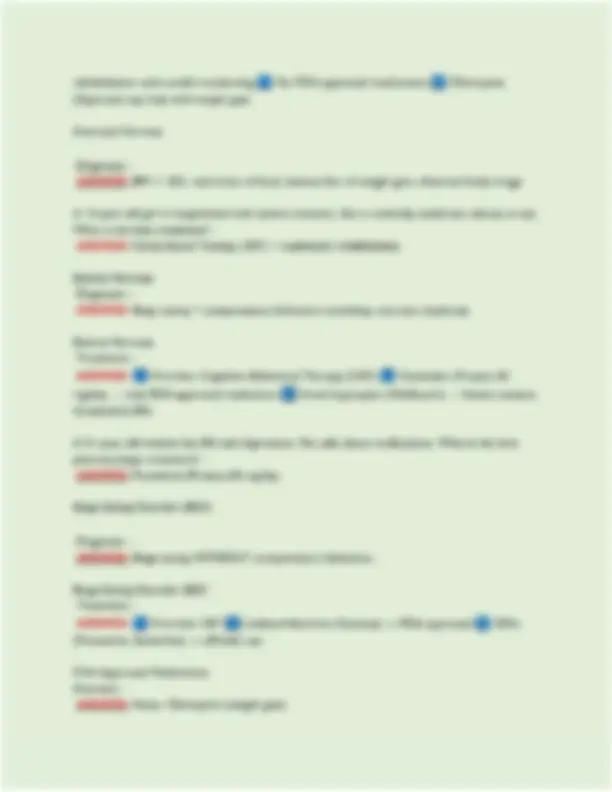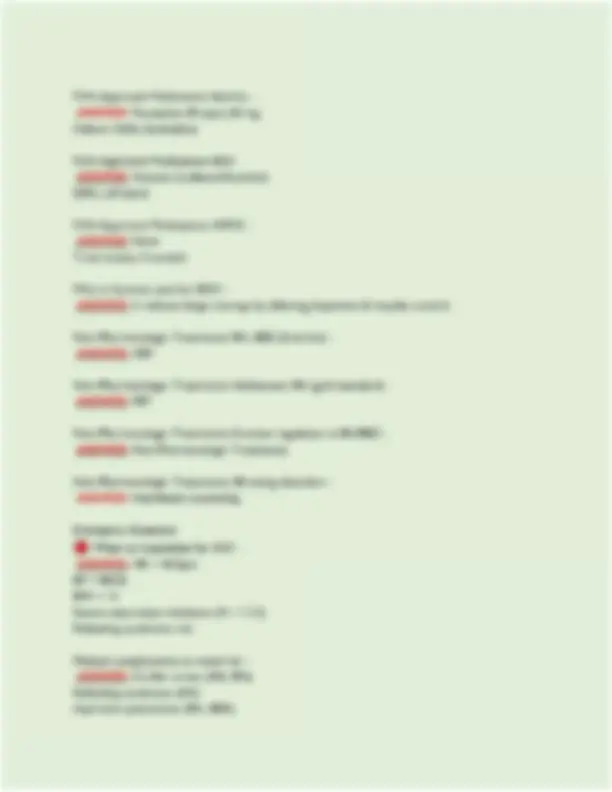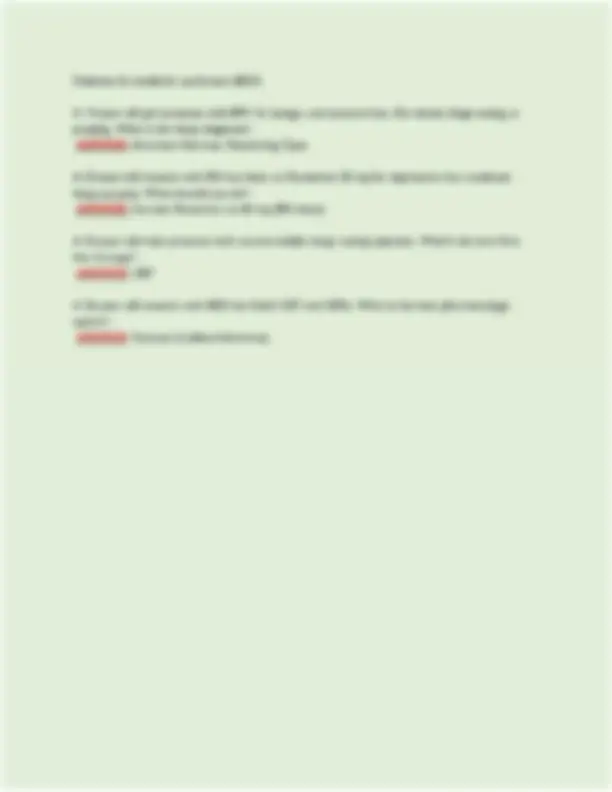Partial preview of the text
Download NU665C/ NU 665C (Latest 2025/ 2026 Update) Exam 2 Psychiatric Mental Health Care of the Fa and more Exams Nursing in PDF only on Docsity!
NU665C/ NU 665C Exam 2 Psychiatric Mental Health Care of the Family Il Guide| Questions & Answers| Grade A| 100% Correct (Verified Solutions)- Regis College A 17-year-old female with a BMI of 16 presents with amenorrhea, lanugo, bradycardia, and severe food restriction. What is the most likely diagnosis? - ANSWER: Anorexia Nervosa (Restricting Type). A 22-year-old college student reports binge eating followed by self-induced vomiting at least twice a week for the last 4 months. Her BMI is normal. What is the most likely diagnosis? - ANSWER: Bulimia Nervosa. A 30-year-old woman has recurrent binge eating episodes without purging. She feels guilty after eating large amounts of food and eats even when not hungry. What is the best pharmacologic treatment? - ANSWER: Lisdexamfetamine (Vyvanse) or an SSRI. A 9-year-old boy refuses to eat many foods due to their texture, leading to nutritional deficiencies and weight loss. He has no body image concerns. What is the most likely diagnosis? ANSWER: AvoidanvRestrictive Food Intake Disorder (ARFID). Anorexia Nervosa (AN) @® Why does hypokalemia occur? - ANSWER: Inadequate intake + purging (if present) = low potassium — risk for cardiac arrhythmias. Anorexia Nervosa (AN) What is refeeding syndrome, and why is it dangerous? - ANSWER: Occurs when a malnourished patient starts eating again. Phosphorus, magnesium, and potassium drop suddenly — can cause fatal cardiac arrhythmias. Prevention: Start feeding slowly and supplement phosphorus. Why do AN patients have bradycardia & hypotension? - ANSWER: Body conserves energy — lowers metabolism, heart rate, and blood pressure to survive starvation. HR < 40 bpm —> may require hospitalization. A |6-year-old girl is brought to the ED for dizziness and fainting. Her BMI is 15.5, and vitals show HR 38 bpm, BP 88/52 mmHg. Labs show hypokalemia, hypophosphatemia, and metabolic alkalosis. What is your next step? - ANSWER: Hospital admission for cardiac monitoring, electrolyte correction, and slow refeeding Bulimia Nervosa (BN) @ Why does vomiting cause hypochloremic metabolic alkalosis? - ANSWER: Loss of stomach acid (HCI) leads to increased bicarbonate, causing alkalosis. What happens to amylase levels in BN? - ANSWER: Elevated amylase is due to salivary gland hypertrophy from frequent vomiting. A 19-year-old college student reports binge eating followed by self-induced vomiting. Labs show hypokalemia, hypochloremia, metabolic alkalosis, and elevated serum amylase. What is the most likely diagnosis? - ANSWER: Bulimia Nervosa Why does BED lead to metabolic syndrome? - ANSWER: Excess calorie intake — weight gain — insulin resistance, high cholesterol, and fatty liver disease. A 35-year-old woman presents with uncontrolled binge eating episodes. She has hypertension, elevated glucose, and a BMI of 33. What medication is FDA-approved for her condition? - ANSWER: Lisdexamfetamine (Vyvanse). Why do non-Western cultures present differently? - ANSWER: Less focus on body image concerns. Eating disorders may manifest as Gl complaints or food avoidance rather than a desire to be thin. @ How does gender affect eating disorder diagnosis? - ANSWER: Men are often underdiagnosed due to stigma. More common in athletes, bodybuilders, and wrestlers. A 25-year-old male wrestler presents with binge eating, excessive exercise, and dehydration. He denies body image concerns. His BMI is normal. What should you consider? - ANSWER: Eating disorder related to weight-class sports (BN or BED). Anorexia Nervosa Treatment: - ANSWER: [jj First-line: Family-Based Therapy (FBT) in adolescents. [] Nutritional FDA-Approved Medications Bulimia - ANSWER: Fluoxetine (Prozac) 60 mg Others: SSRIs (Sertraline) FDA-Approved Medications BED - ANSWER: Vyvanse (Lisdexamfetamine) SSRIs (off-label) FDA-Approved Medications ARFID - ANSWER: None Treat anxiety if needed Why is Vyvanse used for BED? - ANSWER: It reduces binge cravings by affecting dopamine & impulse control. Non-Pharmacologic Treatments BN, BED (first-line) - ANSWER: CBT Non-Pharmacologic Treatments Adolescent AN (gold standard) - ANSWER: FBT Non-Pharmacologic Treatments Emotion regulation in BN/BED - ANSWER: Non-Pharmacologic Treatments Non-Pharmacologic Treatments All eating disorders - ANSWER: Nutritional counseling Emergency Situations @ When to hospitalize for AN? - ANSWER: RR < 40 bpm BP < 80/50 BMI < 14 Severe electrolyte imbalance (K+ < 2.5) Refeeding syndrome risk Medical complications to watch for - ANSWER: Cardiac arrest (AN, BN) Refeeding syndrome (AN) Aspiration pneumonia (BN, BED) Diabetes & metabolic syndrome (BED) A |4-year-old girl presents with BMI 16, lanugo, and amenorrhea. She denies binge eating or purging. What is the likely diagnosis? - ANSWER: Anorexia Nervosa, Restricting Type. A 23-year-old woman with BN has been on fluoxetine 20 mg for depression but continues binge-purging. What should you do? - ANSWER: Increase fluoxetine to 60 mg (BN dose). A 32-year-old male presents with uncontrollable binge eating episodes. What's the best first- line therapy? - ANSWER: CBT A 26-year-old woman with BED has failed CBT and SSRIs. What is the best pharmacologic option? - ANSWER: Vyvanse (Lisdexamfetamine). 













